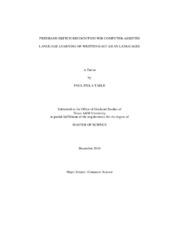| dc.description.abstract | One of the challenges students face in studying an East Asian (EA) language
(e.g., Chinese, Japanese, and Korean) as a second language is mastering their selected
language’s written component. This is especially true for students with native fluency of
English and deficient written fluency of another EA language. In order to alleviate the
steep learning curve inherent in the properties of EA languages’ complicated writing
scripts, language instructors conventionally introduce various written techniques such as
stroke order and direction to allow students to study writing scripts in a systematic
fashion. Yet, despite the advantages gained from written technique instruction, the
physical presence of the language instructor in conventional instruction is still highly
desirable during the learning process; not only does it allow instructors to offer valuable
real-time critique and feedback interaction on students’ writings, but it also allows
instructors to correct students’ bad writing habits that would impede mastery of the
written language if not caught early in the learning process.
The current generation of computer-assisted language learning (CALL)
applications specific to written EA languages have therefore strived to incorporate
writing-capable modalities in order to allow students to emulate their studies outside the classroom setting. Several factors such as constrained writing styles, and weak feedback
and assessment capabilities limit these existing applications and their employed
techniques from closely mimicking the benefits that language instructors continue to
offer. In this thesis, I describe my geometric-based sketch recognition approach to
several writing scripts in the EA languages while addressing the issues that plague
existing CALL applications and the handwriting recognition techniques that they utilize.
The approach takes advantage of A Language to Describe, Display, and Editing in
Sketch Recognition (LADDER) framework to provide users with valuable feedback and
assessment that not only recognizes the visual correctness of students’ written EA
Language writings, but also critiques the technical correctness of their stroke order and
direction. Furthermore, my approach provides recognition independent of writing style
that allows students to learn with natural writing through size- and amount-independence,
thus bridging the gap between beginner applications that only recognize single-square
input and expert tools that lack written technique critique. | en |


